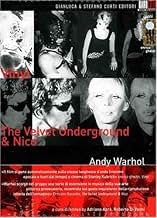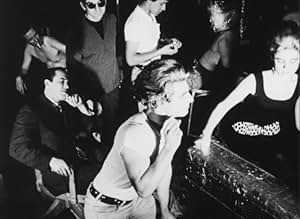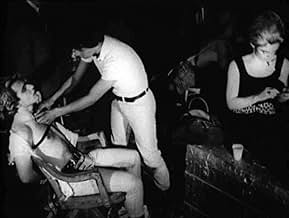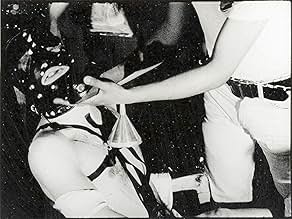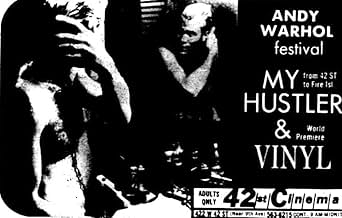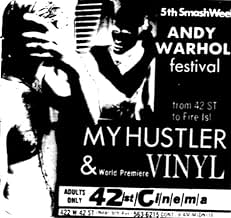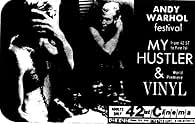Vinyl
- 1965
- 1 h 10 min
AVALIAÇÃO DA IMDb
4,2/10
1,2 mil
SUA AVALIAÇÃO
Adicionar um enredo no seu idiomaWarhol's strange interpretation of "A Clockwork Orange." Includes Gerard dancing to the Martha and the Vandellas classic "Nowhere to Run" and being tortured by professional sadists.Warhol's strange interpretation of "A Clockwork Orange." Includes Gerard dancing to the Martha and the Vandellas classic "Nowhere to Run" and being tortured by professional sadists.Warhol's strange interpretation of "A Clockwork Orange." Includes Gerard dancing to the Martha and the Vandellas classic "Nowhere to Run" and being tortured by professional sadists.
- Direção
- Roteiristas
- Artistas
- Direção
- Roteiristas
- Elenco e equipe completos
- Produção, bilheteria e muito mais no IMDbPro
Avaliações em destaque
Warhol's adaptation (for lack of a more shambling word) of Anthony Burgess' A CLOCKWORK ORANGE begins with a giant closeup of the glowering droog antihero, then moves backward to reveal him narcissistically preening while a crowd of poshy socialites sits blithely by. If this sounds familiar, it's because it's the same opening Stanley Kubrick designed for his version of the book--except that Warhol, working on a sub-Z budget, could only zoom backward, not track.
VINYL is staged in what seems to be a corner of Andy's Factory loft, where a knot of S&M kidnappers, languid dilettantes, plainclothesmen and JD's act out Burgess' fable of a thug's "cure" through mind control. The moralizing of Burgess' novel gets instantly burned away in the wake of a kooky combination of elegant minimalist mise-en-scene, rough-trade heavy breathing, and the usual Warholian giggling at seemingly blithe freaks and damaged goods
Some of the picture lags under the burden of Ronald Tavel's clunky sixties-off-Broadway writing, but the first sequence is sheer amazement--climaxing with the droog Gerard Malanga's motto-delivering monologue (a pinnacle among Warhol is-this-supposed-to-be-bad? scenes) and his nutty chicken dance to Martha and the Vandellas' "Nowhere to Hide"--played all the way through, twice. (The start-up of rendition #2 gets the movie's biggest laugh.)
As always in Warhol, the stasis of the image gives the picture the feeling of a window onto eternity. And the combination of extreme glamour and fox-in-the-henhouse cruelty, framed in compositions that recall heads in a vise, suggests the excitement this work must have had for an ambitious young Bavarian actor-playwright named Rainer Werner Fassbinder.
VINYL is staged in what seems to be a corner of Andy's Factory loft, where a knot of S&M kidnappers, languid dilettantes, plainclothesmen and JD's act out Burgess' fable of a thug's "cure" through mind control. The moralizing of Burgess' novel gets instantly burned away in the wake of a kooky combination of elegant minimalist mise-en-scene, rough-trade heavy breathing, and the usual Warholian giggling at seemingly blithe freaks and damaged goods
Some of the picture lags under the burden of Ronald Tavel's clunky sixties-off-Broadway writing, but the first sequence is sheer amazement--climaxing with the droog Gerard Malanga's motto-delivering monologue (a pinnacle among Warhol is-this-supposed-to-be-bad? scenes) and his nutty chicken dance to Martha and the Vandellas' "Nowhere to Hide"--played all the way through, twice. (The start-up of rendition #2 gets the movie's biggest laugh.)
As always in Warhol, the stasis of the image gives the picture the feeling of a window onto eternity. And the combination of extreme glamour and fox-in-the-henhouse cruelty, framed in compositions that recall heads in a vise, suggests the excitement this work must have had for an ambitious young Bavarian actor-playwright named Rainer Werner Fassbinder.
Andy Warhol very very loosely adapts "A Clockwork Orange". Gerard Malanga tells us all how much of a juvenile delinquent he is and then furious dances to Martha and the Vandellas while Edie Sedgwick watches. Then Ondine, playing his buddy Scum Baby, turns him in to a cop who has been sitting in a chair and laughing the whole time. The cop turns him over to a doctor who tortures him, which seems to be a real S&M kinda deal ... no faking. Malanga is reformed. All of this happens on one set with the whole cast present the whole time. At just over an hour long, it's way too long ... but the peak moments, like Malanga's dance or any randomly selected minute of Sedgwick sitting on the sideline, make the whole thing worth watching.
The brilliance of this movie, is that, Andy Warhol created his version of the greatest film of all time (Clockwork Orange)...SIX YEARS BEFORE the greatest film of all time was even released.
The Opening shot.
The "Old Up Yours."
The Violent "Flickers"
If Kubrick never saw this film...I'd be amazed...
The Opening shot.
The "Old Up Yours."
The Violent "Flickers"
If Kubrick never saw this film...I'd be amazed...
Man, that Andy Warhol must have really not wanted to spend any money on his movies. I can't even really call this a movie, since it follows no story, and no real directing and acting.
Watching this was an horrible experience and it actually felt like a torment. What this movie basically is are Andy Warhol's usual groupies sitting in a corner with a camera pointed at them, doing either weird stuff or absolutely nothing. Appearantly this was Andy Warhol's version and interpretation of Anthony Burgess' 'A Clockwork Orange' but the movie doesn't even follow its story. It's as if Warhol one day picked up a camera and said 'let's shoot something, I'm bored!'. I'm sure they all had good fun doing weird stuff in front of the camera but why bother us with it? The movie doesn't make a point about anything. It doesn't provoke and it's not even artistically a well shot movie.
The camera doesn't move at all, not even when the actors accidentally are out of frame. Also no cuts were made and I'm pretty sure they never rehearsed or prearranged anything. Everything was shot on the spot and things were made up as it moved along. As a result of this the movie just goes on and on, even when absolutely nothing is happening. I seriously had to fast-forward through most of this movie or else I would had most likely never been able to finish it. It was that pointless, annoying and just plain awful to watch.
Funny thing is that the 'actors' themselves also didn't had a clue what they were doing. You can constantly hear voices off cam whispering their lines and saying what they should do next. Besides, they are simply horrible at what they are doing. Edie Sedgwick constantly had a hard time not laughing or looking at the people behind the camera's. Highly annoying and distracting.
Completely unwatchable, even from an artistic viewpoint.
1/10
http://bobafett1138.blogspot.com/
Watching this was an horrible experience and it actually felt like a torment. What this movie basically is are Andy Warhol's usual groupies sitting in a corner with a camera pointed at them, doing either weird stuff or absolutely nothing. Appearantly this was Andy Warhol's version and interpretation of Anthony Burgess' 'A Clockwork Orange' but the movie doesn't even follow its story. It's as if Warhol one day picked up a camera and said 'let's shoot something, I'm bored!'. I'm sure they all had good fun doing weird stuff in front of the camera but why bother us with it? The movie doesn't make a point about anything. It doesn't provoke and it's not even artistically a well shot movie.
The camera doesn't move at all, not even when the actors accidentally are out of frame. Also no cuts were made and I'm pretty sure they never rehearsed or prearranged anything. Everything was shot on the spot and things were made up as it moved along. As a result of this the movie just goes on and on, even when absolutely nothing is happening. I seriously had to fast-forward through most of this movie or else I would had most likely never been able to finish it. It was that pointless, annoying and just plain awful to watch.
Funny thing is that the 'actors' themselves also didn't had a clue what they were doing. You can constantly hear voices off cam whispering their lines and saying what they should do next. Besides, they are simply horrible at what they are doing. Edie Sedgwick constantly had a hard time not laughing or looking at the people behind the camera's. Highly annoying and distracting.
Completely unwatchable, even from an artistic viewpoint.
1/10
http://bobafett1138.blogspot.com/
The first film version of Anthony Burgess' classic 1962 novel A Clockwork Orange is not Stanley Kubrick's celebrated 1971 film of the same name, but a 70-minute art film by no less a person than Andy Warhol. Andy may have had talent in his pop art, but his direction in Vinyl leaves something to be desired.
I just read Burgess' novel for the first time this weekend, and unless people in 1965 had read it first, they might have had considerable difficulty trying to decipher just what in God's name is going on on-screen. The camera stays in one place for the whole movie, which adds to the feeling you're watching a high school play. Indeed, our protagonist reads out his lines with the monotony and lack of emotion you'd expect from high school actors. The film includes a couple things from the book not in Kubrick's version- the protagonist tearing up the books of a victim, a speech about how no one asks why a good person does good things. But in removing the Nadsat, Warhol in effect guts the story of its poetry.
The dancing to music goes on too long, and the protagonist describing what he sees in the conditioning films gets repetitive fast. Although I'll admit, I laughed good when they finally mixed it up with something truly bizarre- "I see little children having their teeth pulled out by yellow dwarfs." Wait, what? At the end of the day, it's Kubrick's version that does the most justice to its source material, and that's the reason it's the most remembered version.
I just read Burgess' novel for the first time this weekend, and unless people in 1965 had read it first, they might have had considerable difficulty trying to decipher just what in God's name is going on on-screen. The camera stays in one place for the whole movie, which adds to the feeling you're watching a high school play. Indeed, our protagonist reads out his lines with the monotony and lack of emotion you'd expect from high school actors. The film includes a couple things from the book not in Kubrick's version- the protagonist tearing up the books of a victim, a speech about how no one asks why a good person does good things. But in removing the Nadsat, Warhol in effect guts the story of its poetry.
The dancing to music goes on too long, and the protagonist describing what he sees in the conditioning films gets repetitive fast. Although I'll admit, I laughed good when they finally mixed it up with something truly bizarre- "I see little children having their teeth pulled out by yellow dwarfs." Wait, what? At the end of the day, it's Kubrick's version that does the most justice to its source material, and that's the reason it's the most remembered version.
Você sabia?
- CuriosidadesIncluded among the "1001 Movies You Must See Before You Die", edited by Steven Schneider.
- ConexõesFeatured in Exploding Plastic Inevitable (1967)
- Trilhas sonorasNowhere to Run
Written by Lamont Dozier, Brian Holland and Eddie Holland
Performed by Martha & The Vandellas
Principais escolhas
Faça login para avaliar e ver a lista de recomendações personalizadas
- How long is Vinyl?Fornecido pela Alexa
Detalhes
- Tempo de duração
- 1 h 10 min(70 min)
- Cor
- Mixagem de som
Contribua para esta página
Sugerir uma alteração ou adicionar conteúdo ausente

